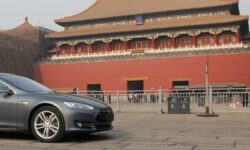Chinese auto makers find another way into global markets
China is on the verge of taking its cars to a global level. This isn’t happening in the traditional way, but through an arguably better, easier and cheaper route. While some Chinese car manufacturers have gained some visibility in markets like Russia, Chile and Iran, others are gaining traction oversees by pairing up with well-known Western brands.
As global markets become more connected through trade agreements, regulation and consumer needs, car manufacturers are now experiencing competition from almost every corner of the planet. And while trade has opened many markets to more players, heightened competition and saturated markets make for a complicated situation. It is not as “easy” as it was for the Japanese manufacturers in the 50s, or as “simple” as it was for the Koreans in the 80s.
Whenever a new brand is born, not only does it have to deal with already established rivals in the market, but with tougher regulation, more complex environmental targets and a more demanding consumer base. This is the reality for the Chinese car brands wishing to enter global markets. The situation becomes even more complicated when their reputation for quality is low. So, what can they do? The latest moves from GM, Ford and Volkswagen are indicative of what we can expect in the coming years.
In 2016, the JMC Yusheng S330, a 4,588 mm long mainstream compact SUV hit the Chinese car market. JMC Yusheng is a sub-brand of Jiangling Motors Corporation, which has a passenger car joint venture with Changan. This is an entirely Chinese vehicle playing in one of the hottest-selling segments. Sales through September indicated that more than 3.4 million units were sold in China, The news here is that Ford, which also runs a JV with Changan, is rebadging the Yusheng S330 to sell in the Ford Territory – not only in China, but abroad too.
Ford presented the Territory at the Sao Paulo motor show in October, hoping to gauge the public’s reaction. The positive feedback means that Ford will start selling the model in Brazil in 2019, after it starts local production in Brazil or Argentina. Based on its specifications and dimensions, the Territory will be positioned as a cross between the Ford Ecosport and the Escape and is likely to reach other markets in the region like Colombia and Mexico. Although it won’t be supplied from China, it’s revealing that China is placing one of its locally designed vehicles in the centre of a very popular segment in Latin America.
But this isn’t a one off. Volkswagen also announced that it is already adapting its Pacheco plant in Argentina to produce the Tharu, the Chinese-conceived and designed compact SUV that was introduced at the latest Guangzhou motor show. Argentina’s car industry needs to reposition the role it plays within the Mercosur trade bloc, because its focus so far has been on compact cars which are losing ground to SUVs. While Brazil focuses its production on small cars and SUVs, Argentina is strong with the midsize pickups and is looking to become a new C-SUV hub. The Tharu is therefore the right product for this market. Like the Territory, the new Volkswagen will be positioned in the C-SUV segment between the T-Cross and the Tiguan Allspace and is set to rival the popular Jeep Compass.
General Motors has announced similar plans and presented the new generation of the Chevrolet Captiva at the latest Bogota motor show in November. Unlike its predecessor, the DNA of this compact SUV is not Korean but Chinese. It’s based on the Baojun 530, one of the latest C-SUVs to hit the Chinese market with very positive results so far (it was the 8th best-selling C-SUV through September). SAIC General Motors is a joint venture that manufactures various models from Chevrolet, Buick and Cadillac. Baojun is another brand produced by the joint venture between GM and SAIC. The new Chevrolet Captiva is expected to sit between the Chevrolet Tracker and the Equinox, and rival the Ford Territory in the so-called entry C-SUV segment. It is expected to be produced in China for the Colombian market, but it could also hit other Latin American countries, and local production could also be a possibility.
In the meantime, Western brands continue to increase their exports from China. Two of the largest markets for Chinese cars in Latin America – Chile and Mexico – confirm how the Chinese-made Chevrolet, Buick and Honda models have gained traction. They counted for almost 73% of Chinese imported car sales through November, or 5.4% of total car sales in those two countries. Even if two of the three SUVs mentioned above are set to be produced in Latin America, the truth is that China is becoming an important source for cars that are expected to be contenders in key segments. It remains true that China might struggle to gain market share with their own brands, but there is a lot of potential for them to rebadge their own cars, and capitalise on the awareness and good reputation that Western brands are known for.












